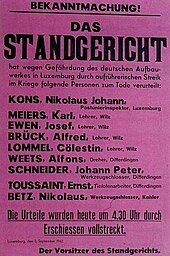Fritz Hartmann (Gestapo)
Fritz Hartmann (born June 7, 1906 in Rabenstein ; † October 19, 1974 in Düsseldorf ) was a German lawyer, National Socialist and war criminal . Between 1941 and 1943 he was head of the Gestapo in Trier and of the Einsatzkommandos of the Security Police and the Security Service (SD) in Luxembourg .
biography
National Socialism
On May 1, 1933, Fritz Hartmann became a member of the NSDAP ( membership number 2,367,334) and completed his law degree the following August . In July 1935 he joined the SS (SS No. 107.331) and became an employee of the Gestapo. On February 1, 1936, he was appointed deputy director of Amt II (enemy research) of the SD headquarters and on October 15, 1937, he was appointed commander of the SD in Berlin .
In January 1940, Hartmann was transferred to Koblenz as head of the Gestapo there , and a year later, as successor to Wilhelm Nölle, he was promoted to head of the Gestapo in Trier and the Luxembourg Einsatzkommando , which made him head of the local police and SD at the same time . Nölle had been removed from office after criticizing the anti-Jewish policies of Gauleiter Gustav Simon , who was also the head of the civil administration in Luxembourg. On September 12, 1941, Hartmann was promoted to the Oberregierungsrat and on January 30, 1942 to SS-Obersturmbannführer , “a Heydrich type , talented, devious, unscrupulous, educated, submissive upwards, brutal downwards”.
From mid-1941, after he had appointed a deputy in Trier, Hartmann concentrated on his tasks in Luxembourg. He organized and supervised the deportation of Jews to ghettos and extermination camps . On October 16, 1941, the first transport left with 331 Jewish people for Litzmannstadt ; most of the deportees were later murdered in the Kulmhof extermination camp . By June 1943 there were six more transports with a total of 352 people. Of the total of 683 people deported from Luxembourg, 43 survived. Resistant Luxembourgers who were imprisoned by the Gestapo were taken to the SS special camp in Hinzert , where Hartmann was also seen more often. The Gestapo headquarters was located in the Villa Pauly in Luxembourg City , and in the post-war trial of Hartmann, victims and witnesses reported abuse and torture there. When at the end of August 1942, after the general strike in Luxembourg, 20 men were sentenced to death by a court martial , Hartmann presided over it. The men were in a quarry near the camp Hinzert executed .
However, after Hartmann was responsible for the arrest of four employees from Hermann Göring's staff , he was removed from office in April 1943 and transferred to the Reich Main Security Office in Berlin on May 31 of the same year . In terms of his departure from Luxembourg, it is said in key words: "Drinking bouts, quarrel with an influential party member, brawl, girl who was killed in a car". On August 12, 1943, he was drafted into the artillery in Prague at his own request . He was then transferred to the SS Junker School in Arolsen , where he stayed from May to October 1944 and completed the officers' course for the Waffen SS . After being transferred to the 5th SS Panzer Division "Wiking" , he was wounded on the Eastern Front in April 1945 .
Post War and Trial
After the end of the Second World War , Fritz Hartmann lived under his name, but forged parts of his biography. He was arrested on June 13, 1946 and taken to Luxembourg on August 3. On the morning of the day of departure, Hartmann tried unsuccessfully to flee, whereupon the responsible US officer slapped him in the face. After this incident and a grueling three-day drive to Luxembourg, Hartmann filed complaints against this officer and with the Prisoner of War Care Center .
He was sentenced to death on February 27, 1951 for his war crimes, but the following December the death penalty was commuted to life imprisonment with forced labor . Six years later, on June 15, 1957, his sentence was reduced again, to 15 years, and on December 19, 1957, he was released after eleven years in prison. Hartmann was deported to the Federal Republic of Germany . The city council of Trier used one of their cars to transport them to his family in Düsseldorf . He then worked as a lawyer in Düsseldorf.
literature
- Marcel Engel / André Hohengarten: Hinzert. The SS special camp in the Hunsrück 1939–1945. Luxembourg 1983.
Web links
- Train rides to doom - overseer. In: Yad Vashem. Retrieved July 11, 2015 .
- Entry on Fritz Hartmann in the Rhineland-Palatinate personal database
Individual evidence
- ↑ a b Engel / Hohengarten, Hinzert . P. 47.
- ↑ a b Engel / Hohengarten, Hinzert . P. 48.
- ^ Frank Göbel: Students do research on the Trier Gestapo. (PDF) In: Trierischer Volksfreund . November 12, 2015, accessed July 11, 2015 .
- ^ The SS special camp / Hinzert concentration camp memorial. (PDF) Blätter zum Land, 2013, accessed on July 11, 2015 .
- ↑ Engel / Hohengarten, Hinzert . P. 49f.
- ↑ Katja Happe u. a. (Ed.): The persecution and murder of European Jews by National Socialist Germany 1933-1945 (collection of sources) Volume 12: Western and Northern Europe, June 1942-1945. Munich 2015, ISBN 978-3-486-71843-0 , p. 602 with note 11.
| personal data | |
|---|---|
| SURNAME | Hartmann, Fritz |
| BRIEF DESCRIPTION | German lawyer, Gestapo officer and war criminal |
| DATE OF BIRTH | June 7, 1906 |
| PLACE OF BIRTH | Rabenstein |
| DATE OF DEATH | 19th October 1974 |
| Place of death | Dusseldorf |

